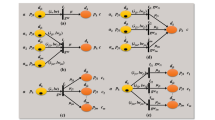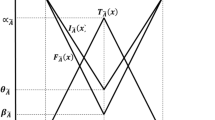Abstract
As an important modeling tool for knowledge representation and reasoning (KRR), fuzzy Petri nets (FPNs) have been applied in kinds of fields. However, there exist some deficiencies for existing FPNs, resulting in application limitations. (1) The sum of membership and non-membership is less than 1, which is hard to model various types of uncertain knowledge by existing FPNs; (2) The reasonable and nonidentical experiential knowledge for electrolysis operation among domain experts should be fused; (3) The existing knowledge reasoning algorithm min, max, and product operators may not work well in many practical applications. In an effort to overcome the shortcomings of existing FPNs, a new type of FPNs is proposed, called simplified neutrosophic Petri nets (SNPNs). First, the simplified neutrosophic sets (SNSs) are introduced into SNPNs, characterized by three independent degrees of truth-membership, indeterminacy-membership and falsity-membership, to depict the experiential cognition of domain experts. Second, the extended TOPSIS (ETOPSIS) is proposed for knowledge fusion. Third, hybrid averaging SNNs concurrent reasoning algorithm (HASCRA) is also proposed to improve the knowledge reasoning efficiency. Finally, a novel model for the identification of superheat degree of aluminum electrolysis cell (ISDAEC) is proposed based on SNPNs. Comparative experimental results show that the SNPNs provide a feasible and practical decision-making method. Moreover, this fact denotes that the proposed method has potential applications in intelligent ISDAEC.











Similar content being viewed by others
References
Liu, H.C., Lin, Q.L., Mao, L.X., et al.: Dynamic adaptive fuzzy Petri nets for knowledge representation and reasoning. IEEE Trans. Syst. Man Cybern. 43(6), 1399–1410 (2013)
Zhou, K.Q., Zain, A.M.: Fuzzy Petri nets and industrial applications: a review. Artif. Intell. Rev. 45(4), 405–446 (2016)
Chen, S.: Fuzzy backward reasoning using fuzzy Petri nets. IEEE Trans. Syst. Man Cybern. B 30(6), 846–856 (2000)
Habib, S., Akram, M., Ashraf, A.: Fuzzy climate decision support systems for tomatoes in high tunnels. Int. J. Fuzzy Syst. 19(3), 751–775 (2017)
Lipp, H.P.: The application of a fuzzy Petri net for controlling complex industrial processes. IFAC Proc. 16(13), 471–477 (1983)
Liu, H., You, J., Li, Z., Tian, G.: Fuzzy Petri nets for knowledge representation and reasoning: a literature review. Eng. Appl. Artif. Intell. 60, 45–56 (2017)
Liu, H.C., Luan, X., Li, Z.W., et al.: Linguistic Petri nets based on cloud model theory for knowledge representation and reasoning. IEEE Trans. Knowl. Data Eng. 30(4), 717–728 (2017)
Zhang, Y., Zhang, Y., Wen, F., et al.: A fuzzy Petri net based approach for fault diagnosis in power systems considering temporal constraints. International J. Electr. Power Energy Syst. 78, 215–224 (2016)
Gniewek, L.: Sequential control algorithm in the form of fuzzy interpreted Petri net. IEEE Trans. Syst. Man Cybern. 43(2), 451–459 (2012)
Li, Z.W., Wu, N.Q., Zhou, M.C.: Deadlock control of automated manufacturing systems based on Petri nets-a literature review. IEEE Trans. Syst. Man Cybern. C 42(4), 437–462 (2011)
Pramod, D., Bharathi, S.V., Raman, R.: A fuzzy Petri-net model for predicting the post-implementation risks of ERP in small and medium enterprises. Int. Rev. Comput. Softw. 9(11), 1852–1860 (2014)
Yue, W.C., Gui, W.H., Chen, X.F., et al.: Knowledge representation and reasoning using self-learning interval type-2 fuzzy Petri nets and extended TOPSIS. Int. J. Mach. Learn. Cybern. 10(12), 3499–3520 (2019)
Liu, H.C., You, J.X., Li, Z.W., et al.: Fuzzy Petri nets for knowledge representation and reasoning: a literature review. Eng. Appl. Artif. Intell. 60, 45–56 (2017)
Liu, H.C., You, J.X., You, X.Y., et al.: Fuzzy Petri nets using intuitionistic fuzzy sets and ordered weighted averaging operators. IEEE Trans. Cybern. 46(8), 1839–1850 (2015)
Shi, H., Wang, L., Li, X.Y., et al.: A novel method for failure mode and effects analysis using fuzzy evidential reasoning and fuzzy Petri nets. J. Ambient. Intell. Humaniz. Comput. 11(6), 2381–2395 (2020)
Li, X., Yu, W., Lara-Rosano, F.: Dynamic knowledge inference and learning under adaptive fuzzy Petri net framework. IEEE Trans. Syst. Man. Cybern. C 30(4), 442–450 (2000)
Ai, Z., Shu, X., Xu, Z.: Simplified interval-valued intuitionistic fuzzy line integrals and their application. IEEE Access 7, 134256–134270 (2019)
Li, H., You, J.X., Liu, H.C., et al.: Acquiring and sharing tacit knowledge based on interval 2-tuple linguistic assessments and extended fuzzy Petri nets. Internat. J. Uncertain. Fuzz. Knowl.-Based Syst. 26(01), 43–65 (2018)
Wang, H., Smarandache, F., Zhang, Y., et al.: Single valued neutrosophic sets. Multispace Multistruct 4, 410–413 (2010)
Alghamdi, M.A., Alshehri, N.O., Akram, M.: Multi-criteria decision-making methods in bipolar fuzzy environment. Int. J. Fuzzy Syst. 20(6), 2057–2064 (2018)
Habib, S., Butt, M.A., Akram, M., et al.: A neutrosophic clinical decision-making system for cardiovascular diseases risk analysis. J. Intell. Fuzzy Syst. 39(5), 7807–7829 (2020)
Chen, S.M.: Fuzzy backward reasoning using fuzzy Petri nets. IEEE Trans. Syst. Man Cybern. B 30(6), 846–856 (2000)
Meng, F.X., Lei, Y.J., Zhang, B., et al.: Intuitionistic fuzzy Petri nets for knowledge representation and reasoning. J. Digit. Inf. Manag. 14(2), 104–113 (2016)
Wang, W., Liu, X.: Interval-valued intuitionistic fuzzy hybrid weighted averaging operator based on Einstein operation and its application to decision making. J. Intell. Fuzzy Syst. 25(2), 279–290 (2013)
Peng, J., Wang, J., Wang, J., et al.: Simplified neutrosophic sets and their applications in multi-criteria group decision-making problems. Int. J. Syst. Sci. 47(10), 2342–2358 (2016)
Akram, M., Shumaiza, Arshad, M.: Bipolar fuzzy TOPSIS and bipolar fuzzy ELECTRE-I methods to diagnosis. Comput. Appl. Math. 39(1), 1–21 (2020)
Zadeh, L.A.: Fuzzy sets. Inf. Control 8(3), 338–353 (1965)
Atanassov, K.T., Parvathi, R.: Intuitionistic fuzzy sets. Fuzzy Sets Syst. 20(1), 87–96 (1986)
Smarandache, F.: A Unifying Field in Logics. Neutrosophy: Neutrosophic Probability, Set and Logic. American Research Press, Rehoboth, DE (1999)
Vafadarnikjoo, A., Mishra, N., Govindan, K., et al.: Assessment of consumers’ motivations to purchase a remanufactured product by applying Fuzzy Delphi method and single valued neutrosophic sets. J. Clean. Prod. 2018(196), 230–244 (2018)
Ye, J.: A multicriteria decision-making method using aggregation operators for simplified neutrosophic sets. J. Intell. Fuzzy Syst. 26(5), 2459–2466 (2014)
Majumdar, P., Samanta, S.K.: On similarity and entropy of neutrosophic sets. J. Intell. Fuzzy Syst. 26(3), 1245–1252 (2014)
Yang, H.L., Zhang, C.L., Guo, Z.L., et al.: A hybrid model of single valued neutrosophic sets and rough sets: single valued neutrosophic rough set model. Soft. Comput. 21(21), 6253–6267 (2017)
Liu, C., Luo, Y.: Power aggregation operators of simplified neutrosophic sets and their use in multi-attribute group decision making. IEEE/CAA J. Autom. Sin. 6(2), 575–583 (2017)
Peng, J., Wang, J., Zhang, H., et al.: An outranking approach for multi-criteria decision-making problems with simplified neutrosophic sets. Appl. Soft Comput. 25, 336–346 (2014)
Liu, H.C., Liu, L., Lin, Q.L., et al.: Knowledge acquisition and representation using fuzzy evidential reasoning and dynamic adaptive fuzzy Petri nets. IEEE Trans. Cybern. 43(3), 1059–1072 (2013)
Meirbekova, R., Haarberg, G.M., Thonstad, J., et al.: Influence of sulfur species on current efficiency in the aluminum smelting process. Metall. Mater. Trans. B. 47(2), 1309–1314 (2016)
Xu, X.G., Shi, H., Xu, D.H., et al.: Picture fuzzy Petri nets for knowledge representation and acquisition in considering conflicting opinions. Appl. Sci. 9(5), 983 (2019)
Zhao, S., Xie, Y., Yue, W., et al.: A machine learning method for state identification of superheat degree with flame interference. In: 10th International Symposium on High-Temperature Metallurgical Processing, pp. 199–208. Springer, Cham (2019)
Acknowledgements
Supported by the National Natural Science Foundation of China (62103378, 62003311); Natural Science Foundation of Henan province (202300410503); Key projects of Science and Technology of Henan Province (212102210506, 202102310284); Innovation incubation project of Zhengzhou University of Light Industry (2020ZGKJ211); The doctoral research fund of Zhengzhou University of Light Industry (2020BSJJ001).
Author information
Authors and Affiliations
Corresponding authors
Ethics declarations
Conflict of interest
The authors have no conflict of interest to declare.
Rights and permissions
About this article
Cite this article
Yue, W., Wan, X., Li, S. et al. Simplified Neutrosophic Petri Nets Used for Identification of Superheat Degree. Int. J. Fuzzy Syst. 24, 3431–3455 (2022). https://doi.org/10.1007/s40815-022-01310-2
Received:
Revised:
Accepted:
Published:
Issue Date:
DOI: https://doi.org/10.1007/s40815-022-01310-2




